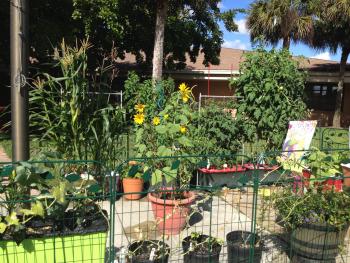
"Veggin' Out"

- School:
- Golden Terrace Elementary
- Subject:
- Science
- Teacher:
- Joyce Cordell
- Students Impacted:
- 500
- Grade:
- Pre K - 5
- Date:
- September 5, 2018
Investor
Thank you to the following investor for funding this grant.
Suncoast Credit Union - $220.00
Original Grant Overview
Goal
My goal is to continue to collaborate to provide students real-life, hands-on experiences planting and caring for a vegetable garden. Utilizing a scientifically engineered container garden system, students will learn a variety of standards based Science concepts including the water cycle, life cycles, soil, nutrition, insects, and plants. Students will participate in the planning and maintaining of the garden area for school wide learning and enjoyment.
What will be done with my students
I will collaborate with the Science Coach and second grade teachers to help guide students through the challenges and rewards of gardening. We will prepare our garden area, the Earth-boxes, and various pots for planting tomatoes, peppers, cucumbers, green beans, broccoli, lettuce, and herbs. Ornamental plants and flowers will also be planted to attract pollinators and beautify the garden. Lessons will include the properties of water, light, and soil. Plants, insects, and nutrition will also be studied. The scientific method will be taught during student-driven experiments. We will plant and replant seeds and seedlings throughout the year. As students care for their garden, they will use a variety of inquiry skills such as making observations, recording and measuring data, predicting, and drawing conclusions.
Benefits to my students
The benefits of gardening with students are many! Authentic learning occurs across the curriculum. Integrating subjects and concepts increases learning and helps students make connections. Although second graders are the gardeners, pre-k, kindergarten, and first grade students regularly visit the garden. It is a perfect spot for that "teachable moment" for all grade levels. Many science concepts are very abstract and difficult for students to truly understand and master. A school garden generates enthusiasm and excitement. Science concepts become more relevant and meaningful to students. Students will experience the water cycle and analyze soil. They will observe plant parts and learn their functions. They will evaluate growing conditions and make decisions based on their observations. They will experience the entire life cycle of a plant and hopefully enjoy the fruits of their labor. They will learn about healthy eating and growing vegetables without harmful chemicals. Students will actually be applying the skills that they learn and read about. These activities build teamwork and foster a sense of community and pride in our school..
Budget Narrative
7 Earth-boxes, various pots, and gardening tools have been purchased in previous years. This year the budget includes soil and plants that will allow for two growing seasons and gardening throughout the school year. Miscellaneous items may include organic pesticide, plant supports, wind chimes. signage, etc.
Items
| # | Item | Cost |
|---|---|---|
| 1 | Ornamental plants | $30.00 |
| 2 | Vegetable/herb seedlings | $65.00 |
| 3 | Bags of potting mix | $75.00 |
| 4 | Miscellaneous garden accessories | $50.00 |
| Total: | $220.00 |



Share
Please share this page to help in fulfilling this grant.
Email to a Friend